Department of Energy Experiments with Power Storage
Department of Energy Experiments
Lately the Department of Energy (DOE) has released funds for a number of experimental means of storing power. This may sound like an odd idea, but it's not.
The electricity you use everyday, save that in your car, is produced as you use it. None of it is stored for later use and only the occassional company or individual has experimented with saving energy when it's cheap to produce so that it can be used later.
The DOE is currently funding two projects that may one day be the very means we need to store energy produced by the sun, wind, or waves so that it can be used after sunset, when the wind dies down, or when the ocean (or lake) is calm.
One of these technologies is flywheel energy storage. The other is a more exotic means of storing energy with superconducting wire and extremely strong magnetic fields.

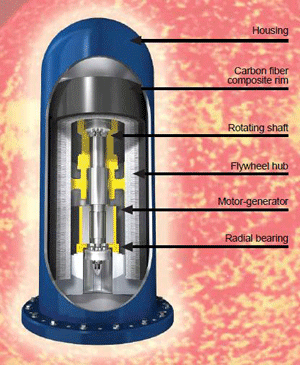
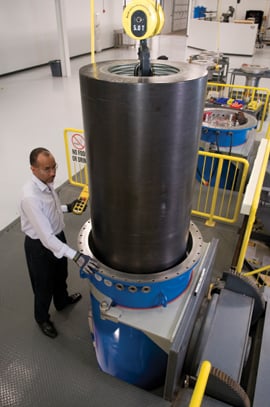
The Flywheel Energy Sink
The federal government is backing a loan guarantee forty-three (43m) million dollars to Beacon Power of Massachusetts for an experiment in stored power. Beacon says their plant will be able to store twenty (20MW) megaWatts of power off-line. In the past the best anyone has been able to accomplish is about one megaWatt. The DOE is not only backing roughly sixty percent of this loan another thirty some odd percent is being backed by the New York Energy Research and Development Authority.
Flywheel energy storage has been tried in the past, but a number of problems have always cropped up. First, the flywheel must sustain speeds in the hundreds of thousands of revolutions per minute. Getting the flywheel up to those speeds requires special bearings and a complete vacuum. Second, flywheels tend to disintegrate at such high speeds so special housings must be built to contain them. In other words, to date the expense to manufacture these special energy storage devices has not been balanced out by any benefits.
However, with advances in materials, it may now be possible. Beacon Power is experimenting with a flywheel made of carbon-fiber (a first) spinning in a vacuum.
Beacon's flywheels are carbon fiber housed in heavy-duty steel enclosures that stand over two meters high. Each flywheel is one meter in diameter and at power spin constantly at around sixteen thousand (16,000RPM) revolutions per minute. That means the outer edge of the flywheel experiences a speed of Mach 2. At speed each flywheel unit can supply one hundred (100kW) kiloWatts of electricity for fifteen (15) minutes.
As with past designs these flywheels will store electricity as spinning force when an overabundance of power is generated. When demands are made on the power grid the energy can be instantly accessed from the flywheel, slowing it down. At this point in time natural gas fired power plants take up these surges in demand, but a flywheel system would be much more responsive and much more environmentally friendly.
Naturally this system will make storage of fluctuating energy sources (such as wind, solar and tidal) much more feasible.
The Stephentown plant will host two hundred flywheel storage systems on completion.
The pilot plant is being built in Stephentown, N.Y., and it will initially augment the natural gas plants meet the power grid's fluctuating demands. Once this plant is fully on-line Beacon projects that it will provide about ten percent of frequency fluctuation service in New York per day.
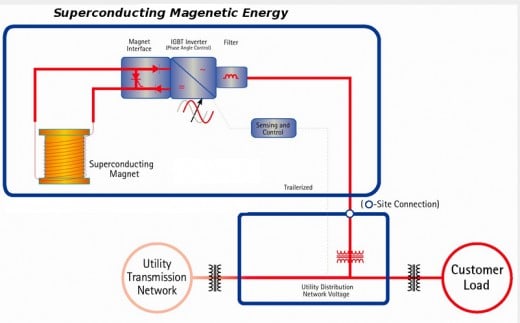
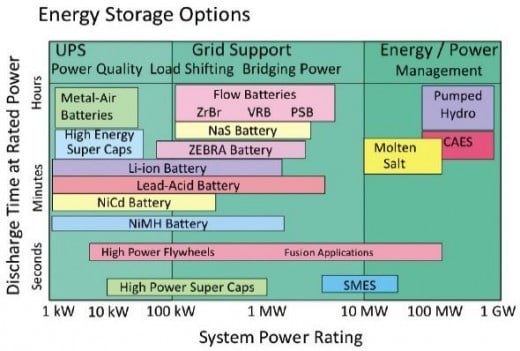
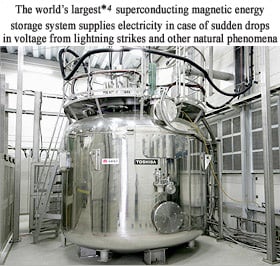
The Superconducting Magnet Energy Sink
The DOE has also invested four point two (4.2m) million dollars in a technology that could store energy in superconducting wire and magnetic fields.
The technology, Superconducting Magnetic Energy Storage (SMES) can work at the power grid level. The amount is an ARPA-E funded grant.
Swiss engineering firm ABB Group and a handful of other partners. These firms plan to build a 3.3 kilowatt hour proof-of-concept SMES prototype. As projects go this is a small one, but this is the first time this technology has been used in this way. If the proof of concept works the system could be scaled up to work on multi-megawatt-hour capacity systems.
SMES is, essentially, a capacitor made of magnetic fields. The DOE is expressing interest in this technology because, unlike flywheel or other storage systems, this technology could easily be scaled into huge facilities that could efficiently store massive amounts of electricity. Best of all the system could be called upon to fill gaps in demand instantly.
Details are scarce, but the SMES systems work by storing electricity in huge magnetic fields generated by running direct current through superconducting wires. The geometry of the fields and wiring allow for the storage of vast amounts of energy while using very little energy to maintain the field. Drawing current from these systems is also very rapid. This will make these systems, if they pass the proof of concept stage, a viable means of storing power during off-peak hours and release that power back to the grid when demand is high.
See image right.
Coda
That the Department of Energy is spending money on these technologies demonstrates a commitment on the part of the Federal Government toward storing energy when every grid in the country currently produced electricity on demand.
Though I'm sure some readers will find fault with the funding and these studies, I feel this is an important step in the right direction.
We are entirely dependent on power plant's production capacity in real time. The current systems work so well that most of us don't realize that the energy we use is being created as we use it. And this is positive testament to the companies that create our power. They clearly have a commitment and dedication to their customer base.
However, power companies that can store electricity as it is created during off hours will be that much more efficient, possibly be able to charge less for power generated, and will be able to more completely explore energy generation that does not depend on fossil fuels.
Disclaimer
The author was not compensated in any way, monetarily, with discounts, or freebies by any of the companies mentioned.
Though the author does make a small profit for the word count of this article none of that comes directly from the manufacturers mentioned. The author also stands to make a small profit from advertising attached to this article.
The author has no control over either the advertising or the contents of those ads.








